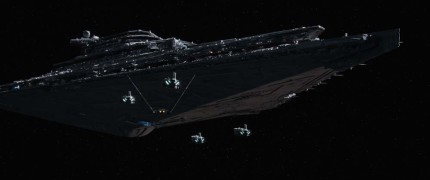From the Disney Insider

When the original Star Wars was released in 1977, its groundbreaking visual effects ignited the imaginations of countless viewers who had never seen anything like it before. The effects work done by Industrial Light & Magic, a company formed by director George Lucas for the sole purpose of providing the film with its otherworldly imagery, was light-years beyond what was thought possible, both in terms of special effects (effects done on set) and visual effects (those accomplished during post production). And in the subsequent Star Wars films, both the original sequels and the prequels, the boundaries of what was capable was pushed further and further, right up to the release of last year’s Star Wars: The Force Awakens, which is nominated for an Academy Award for Best Visual Effects.
And there’s a reason that the visual effects in Star Wars: The Force Awakens are so special, one that harkens back to the original Star Wars and the first time audiences were transported to a galaxy far, far away.
Back in 1977, special effects were even more cumbersome to produce, utilizing models, forced perspective, matte paintings, optical compositing, animatronics, and puppetry. Most visual effects today are achieved exclusively through computer-generated imagery, which seem to make monumental leaps in terms of complexity and realism with every passing year. What makes Star Wars: The Force Awakens so special is, like the rest of the film, it makes a decided turn towards retro technology, and combines that with the most cutting-edge effects, to create a world that is tactile, shop-worn, and unbelievable looking.
The specialness of the special effects make themselves known early in the movie: When Rey (Daisy Ridley, in an instantly iconic performance) is scavenging on the desert planet Jakku, she passes by giant bird-like creatures called steelpeckers who feast on the junk that litters the planet’s sandy surface. Instead of a computer-generated creature, these are wondrous, high-tech puppets. (Other puppet wonders include the biomechanical Luggabeast, the nightwatcher worm, and of course, adorable droid BB-8.) As Rey zips by a downed Star Destroyer, the image is a 21st century matte painting: digital in execution but analogue in spirit. Later, a computer generated Millennium Falcon blasts through the same Star Destroyer, although this time it’s rendered in three dimensions, giving it cavernous depth and the defeated menace of a predator’s skeleton. An even better example is Unkar Plutt (played by a wholly disguised Simon Pegg), the junk dealer who is also Rey’s employer. He is a physical character (Pegg was there), but his face, which resembles a blob fish (look it up), is achieved via computer wizardry.
Again and again these practical effects and old school approaches mix with the most groundbreaking visual effects. Take the sequence inside Maz Kanada’s castle, which serves as a creature-filled saloon. When the sequence starts, we pass by a giant, fearsome beast named Grummgar, who sits with Bazine Netal (Anna Brewster), a mercenary who seems, more or less, human. There are additional physical characters, like Guiggold, Captain Ithano, and the werewolf-like Hassk Triplets. But when the sequence ends, we’re introduced to Maz herself (Oscar-winning actress Lupita Nyong’o), who is achieved through the latest in computer generated motion capture technology. It’s almost like every advancement in the Star Wars filmology is colliding in a single film, from the animatronics, and the make-up and puppetry of the cantina sequence in the original Star Wars, to the breakthroughs in motion capture technology in the prequels, everything exists side-by-side and compliments each other. What’s so fantastic about Star Wars: The Force Awakens is that it doesn’t suggest one approach is inherently superior to the other, but serves as proof that they can exist side by side, and mutually elevate each other and the film. The animated characters and effects are unachievable practically, pushing the visuals to an almost hallucinogenic level, while the physical effects allow actors to make eye contact and interact with something on set, since those effects are more tangible and real.
Star Wars has always been great at making wild fantasy worlds seem utterly real, and Star Wars: The Force Awakens is no different. There are 2100 visual effects shots and they all unfold with a magician’s nimble sleight of hand. Was that a puppet? Computer generated image? Matte painting? You never know. Star Wars: The Force Awakens director J.J. Abrams and his small army of artistic collaborators, technicians, and craftspeople, make sure to always change their methodology, swapping one gag for another, which keeps the audience engaged, surprised, and completely fooled, in a way that only a Star Wars film is capable of.
- Disney Hotel wins Marriott Hotel of the Year Award - July 26, 2024
- All-Female Classic Universal Monsters Headline HHN House - July 25, 2024
- Howl-O-Sprint – Run for Your Life: Friday, Sept. 13 - July 24, 2024





